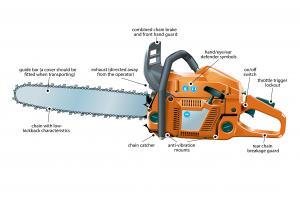Risks
The risks associated with using chainsaws vary greatly depending on whether the chainsaw is being used from a height, for example from ladders, ropes, in trees, or from the ground.
As most farmers tend to fell trees and branches at ground level, the following information should be followed in this situation.
Safe saw
All chainsaws are slightly different depending on the make and model.

In order to use a chainsaw safely it is essential they are properly maintained and that operators are trained to keep the chainsaw in a safe working condition.
The chainsaw must always be maintained in accordance with manufacturer’s recommendations.
Before use, operators need to check the following:
- the on/off switch is clearly marked and functioning correctly
- the side plate, front and rear hand guards are fitted, in position and in good working order, with the chain, guide bar and sprockets and chain catcher undamaged
- a chain with low kick back is used
- the chain is properly sharpened, tensioned and lubricated
- the chain brake is properly adjusted and working correctly
- the silencer and anti-vibration mounts are in good working order
Safe operator
Anyone who undertakes cutting as part of agricultural operations do not need to hold a relative certificate of competence or national competence award if they have used a chainsaw before 5 December 1998. However, under the Provision and Use of Work Equipment Regulations, operators must be competent in chainsaw use and must be able to demonstrate this if questioned by an HSENI inspector.
Farmers must consider new workers, students and young people (even family members) in terms of their level of experience and awareness of risk.
If you are unsure of the legal requirements in relation to training in chainsaw use, please contact your local training providers or awarding bodies, such as Lantra NI:
- phone: 07867 908171
- email: ni@lantra.co.uk
Fitness and personal protective equipment (PPE)
Farmers must also consider a person’s fitness - including their own. Certain medical conditions or even a person’s age and dexterity may affect their ability to operate a chainsaw safely.
Never use a chainsaw without wearing the correct personal protective equipment (PPE).
All operators must wear the following as a minimum:
- chainsaw safety helmet to BS EN 397
- hearing protection to BS EN 352-1
- eye protection, either mesh visors or safety glasses to BS EN 1731 or BS EN 166
- chainsaw gloves to BS EN 381-7
- chainsaw leg protection to BS EN 381-5
- chainsaw boots to BS EN ISO 20345
Operators must also ensure all PPE is properly maintained and that they are properly trained in its use.
Any other clothing worn must be close-fitting to avoid the potential for snagging.
Remember, no protective clothing can ensure 100 per cent protection against cutting by a chainsaw, but it can reduce the risk of major injury in certain circumstances.
Safe site
Always try to avoid working alone with a chainsaw. If this is not possible, work out how you will raise the alarm if something goes wrong, for example, the use of a mobile phone pre-set button.
Where possible use a pre-arranged call-in system to help keep others aware that you are safe.
The main points to consider when assessing a site before tree work and chainsaw use are:
- ensure any overhead power-lines are further than two tree lengths from any tree to be felled or at least 10m from any other tree work
- you have agreed with your local distribution network operator when or if the power is to be turned off due to the location of overhead power lines
- you have agreed with your local distribution network operator when the power is to be re-energised
- you have taken into account the position of roads, footpaths or public access and you have provided warning signs, barriers or closed roads if necessary
- you know the direction the tree will fall ensuring there is no danger to yourself or others and you have selected a clear escape route
- no-one is within two tree lengths of the tree being felled
- the operator has a secure foot hold and as clear a site as possible
Resources
- Farmwise - your essential guide to health and safety in agriculture - HSE (GB) website (pages 36 to 38)
- Working with chainsaws - HSE (GB) website
- City and Guilds Level 2 award in chainsaw and related operations (QFC) CS 30 - prepare and maintain the chainsaw
More information
- The Forest Industry Safety Accord website
- Maintaining trees and hedges on your property - NIE website
